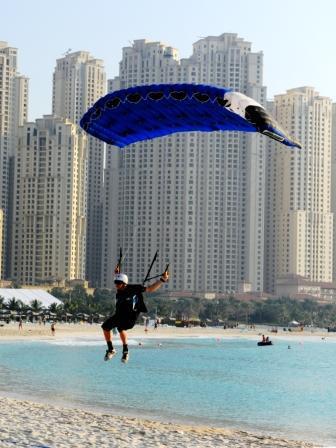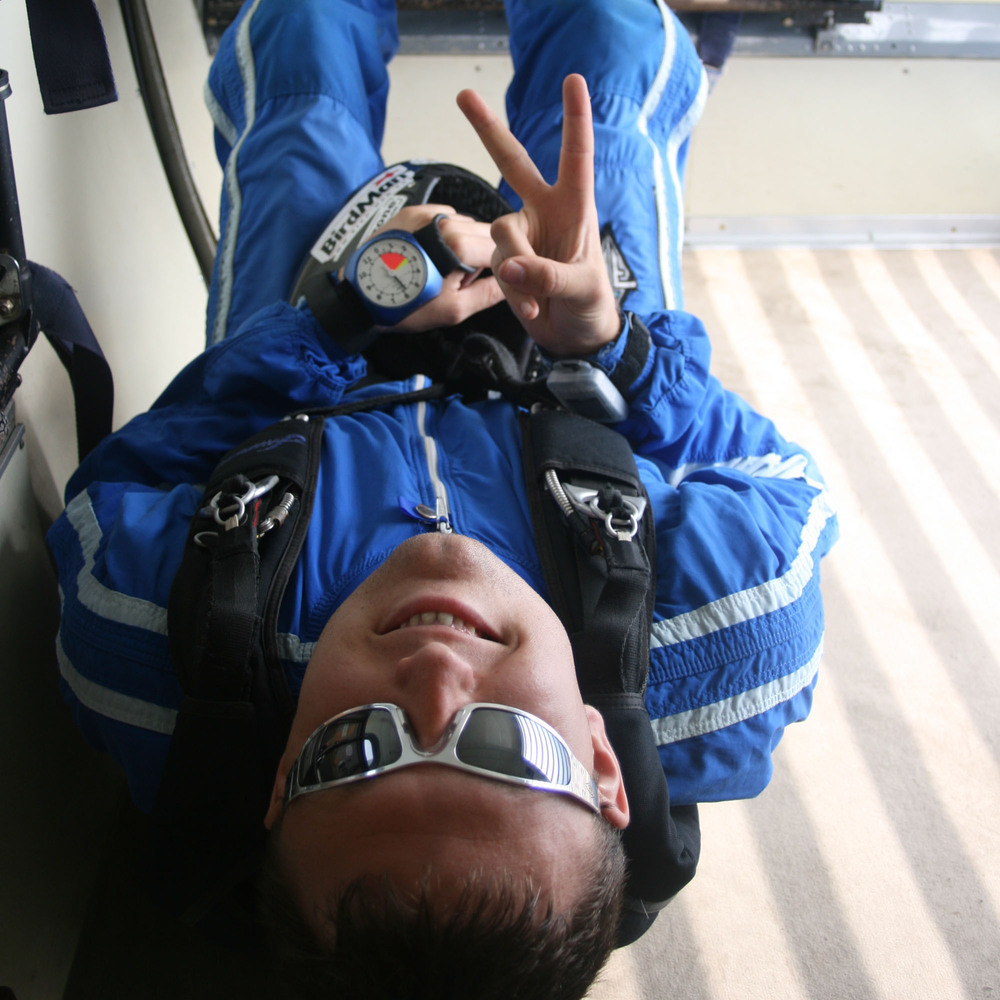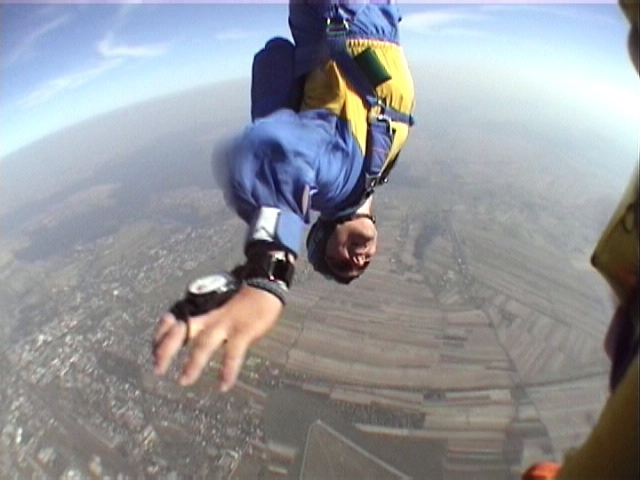Recommended Posts
rhys 0
QuoteNo they don't and if you believe so, you're not doing it right.
There is a fair amount of assumtion in that comment.
I am assuming you are commenting on this comment of mine?
QuoteGainers can allow you to have the drogue out(stable) in less time than a poised exit, if you so wish to do so.
When you say no they don't, explain how so.
I have seen quite a few guys in different places, that do have the drouge out within a very short period of time, the gainer is not much more than a 100 degree rotation and your bellys are into the wind. The rotation can be controlled and the relative wind is still from the direction of the prop blast, minus a couple of degrees.
Read your reply again
***No they don't and if you believe so, you're not doing it right. I've got 6000+ tandems and far more than a "few" intentionally unstable exits, that say I'm right. You fail to grasp the concept that it's not your skydive and the student is incapable of making an informed decision about an unstable exit.
I have never performed gainers that way or for that purpose and have never intended on doing so. I simply stated that they can be done like that.
I would rather complete the rotation fly stable and have the drogue out within 3-5 seconds, as the rules that apply to me most of the time allow.
As a videographer (2500 jumps) I have witnessed many unstable exits, some were trying to do poised stable exits and others were truing to; look cool, fly out of thier ability or were simply being incompetant.
Bad exits are for the most part for the most part not the students' fault, though they are more often than not blamed for them.
Once a t/m is able to fly all the exits with no trouble, then they may have the competence to try such manoevers. This can take hundreds of tandems, and there are many tandem master with 1000's of tandems that still cannot do this.
I have done 40 tandems in the last 3.5 days and have done 2 gainers. Wow, what a 'crazy guy'!
I prefer to fly with the camera guy, not shouve my ass in his face, when I have outside camera, I will have handicam only in a few months will be plenty of time for gainers then.
QuoteYou fail to grasp the concept that it's not your skydive and the student is incapable of making an informed decision about an unstable exit.
It is both of our skydives, as an instructor you are paid to give the customer a good, safe experience. This means that you remain in your comfort zone and experience level.
A tandem does not need to be a stage 1 aff type jump as it is an introductory dive. The experience of the tandem instructor allows the level of difficulty that will remain in the safe category.
It begins with the introduction, the briefing and continues until you shake thier hand wave goodbye and say "see ya next time for your solo course."
If a customer of mine knows I am going to do a gainer, I'll let them know it will only happen if they are relaxed and I am happy with thier performance, (this is my criteria whether or not they know it is going to happen) they feel a great sense of achievment, after I do it even though i am capable if performing it with a less than perfect body poistion.
Whether they do a gainer or not they all have a good time. I do about 1000 of these a year nowdays, I am allowed to make it a little fun for me also.
Unstable used to be anything 'not on your belly'.
I have only been skydiving 7 years so this was before my time!
rhys 0
Quote: >there is no reason why they should not be as safe for any experienced skydiver
>with the correct training to conduct.
They're not "just as safe.*" They're not "just another skydive." That attitude, IMO, is a problem both with exceptional skydives (i.e. intentional cutaways) and tandems.
So what makes you any more capable than another to be able to perform this manoever?
You had training? We/I could get training. What makes you so special?
Quote(* - As just one example, ask yourself how you'd deal with a three-out.)
Proablably the same as you once I had the training, Avoid a 3 out would be the first step I suppose!
The funny thing about this whole debate is that where I am from gainers are acceptable but doing tandems with less than 1000 jumps is not, I didn't do my rating until about 2200 jumps and that is common also where I am from.
And a piece of advice given that was not necessarily explained very well;
QuoteQuote
My second favorite Skyvan exit was to tell the student to pick up their feet - a couple of metres from the edge - then I turned to face the pilot and hopped off, head-high and was immediately stable.
(From an instructor with low experience - less than 500 tandems)"i'll give this one a shot next time Smile - if my passengers are not in the 1.8 meters/85kilos+ class again" [Crazy]
flashed by, taken from a newer tandem master and not commented on!
Now I am not by any means taking a shot at you feuergnom, but is was a perfect example of hypocracy and bad advice.
Where the manover in question may be perfectly acceptable, the advice to the customer is not standard practice, not explained very well and is more likely to promote an unstable exit, than performing the correct body position and doing a gainer.
I would like to know what is meant by "My second favorite Skyvan exit was to tell the student to pick up their feet - a couple of metres from the edge - then I turned to face the pilot and hopped off, head-high and was immediately stable. "
What does that mean exactly (I do actually want to know),
[proving a point] That isn't safe, that is not the manufacturers' recommendations, you shouldn't do that, you might go unstable! [/proving a point]
PhreeZone 20
QuoteI would like to know what is meant by "My second favorite Skyvan exit was to tell the student to pick up their feet - a couple of metres from the edge - then I turned to face the pilot and hopped off, head-high and was immediately stable. "
What does that mean exactly (I do actually want to know),
[proving a point] That isn't safe, that is not the manufacturers' recommendations, you shouldn't do that, you might go unstable! [/proving a point]
Actually this is the exit as described in the UPT Vector 2 tandem manual in figure 4 on page 67 (Cessna exit). The student is fully suspended from the instructor in the correct freefall position (legs up, arched, holding the harness and head back. The instructor then moves to the door and performs their exit, for a tailgate this is just a single step backwards off the gate and you can throw the drogue at almost the moment you are clear of the plane since both bodies are perfectly stable.
And tomorrow is a mystery
Parachutemanuals.com
billvon 3,058
>this manoever?
I'm not. Anyone with my experience who is willing to put in the time should be able to pull it off. But I still wouldn't do it with a student.
rhys 0
QuoteI'm not. Anyone with my experience who is willing to put in the time should be able to pull it off. But I still wouldn't do it with a student.
so your point is?
billvon 3,058
?? You asked the question; I answered. What was _your_ point?
Driver1 0
QuoteIt depends, back flips are not the best idea out of a King air/other small door plane. IMHO, it's extra work getting turned around in any plane (except CASA/Van) and after doing a dozen+ jumps a day it's not worth the effort.
Will
Is this the type of exit that you are referring to? http://www.youtube.com/watch?v=YZE_yCJD6to
Why is this a bad idea?
I think this actually shows why they are OK to do. Look how perfect this exit goes!
I think the videoagrapher could use some work as the angles and amount of seperation is horrible!
But the tandem pair seemed to be in perfect form and stable even with the back flip!
riggerrob 643
I don't get it??????
Lazy old me (52 years old) finds it much simpler and easier and less work to face the propeller and do a stable exit, belly into the wind.
mnealtx 0
Quotei dunno if you or bill hold the 'Crap Analogy' title.
We have to use 'crap analogies' because nothing else seems to get through to you.
QuoteYou are now trying to say that doing a gainer with a coherent, relaxed tandem customer poses the same peril as telling a student to do a 90 on landing.
No, I'm not - I'm saying that BOTH are more dangerous and the student does not yet know enough to make that decision.
Quote[sarcasm]I take it you are talking from experience?[/sarcasm]
Yes, actually I am - I *have* taken instruction in risk management.
Now, do you have any other "crap questions", or do we need to make even more extreme examples to get you to THINK?
I love you, Shannon and Jim.
POPS 9708 , SCR 14706
JohnMitchell 16
That makes 2 of us. We suck.Quote
Lazy old me (52 years old) finds it much simpler and easier and less work to face the propeller and do a stable exit, belly into the wind
Some of the TM's I work with, and I respect all of them, do flips on exit. I rarely do. It seems, though, this season, I've seen more and more stable exits. Happiness is an easy drogue throw, eh?
QuoteThat makes 2 of us. We suck.Quote
Lazy old me (52 years old) finds it much simpler and easier and less work to face the propeller and do a stable exit, belly into the wind
Some of the TM's I work with, and I respect all of them, do flips on exit. I rarely do. It seems, though, this season, I've seen more and more stable exits. Happiness is an easy drogue throw, eh?
I'm mostly with you on this. I prefer a poised exit from a side-door aircraft and am only very rarely convinced to backloop from one. However, from a tailgate, I prefer the back layout exit to backing out the door, mostly because it seems safer to me, and just as stable. Of course, I don't jump tailgates very often, so the distinction is kind of moot.
Blues,
Dave
(drink Mountain Dew)
Quote" ... Define unstable? ..."
........................................................................
----------- any rotation more than 90 degrees from belly-to-wind. ----------------
By your definition Rob every exit I do off a 182 is unstable.
http://www.youtube.com/watch?v=IK1qXDBbKtM&feature=related skip forward to 3:30 for exits. This is not a cherry picked video, the student posted it.
Years ago I decided to quit fighting the forward roll momentum, and let the thing go on over. I do a full front flip, tapping the student as we go off. About half way over, and the point when the student is again aware, we arch. It'll over rotate back to head down, then roll back. The advantages I see; I virtually never go side to the wind, I'm working with the student as opposed to fighting them or not trying to get the drogue out before the student can make us unstable.
I've seen more than a few TIs go off arch hard, and simply try to ride out whatever the student does, fighting as opposed to working with. I like it, it works well for me, but not necessary promoting it.
Mark (tandem I shoot going off before me) chooses to exit and stay as stable as he can. He steps off (I think) more to reduce the rolling momentum.
Martin
edit to make it clicky
AC DZ
TopGun 0
"The funny thing about this whole debate is that where I am from gainers are acceptable but doing tandems with less than 1000 jumps is not, I didn't do my rating until about 2200 jumps and that is common also where I am from"
So where are you from?
Watch part 3 of lock and loads episode on helicopters.
This shows a time where a back loop may have been better.
rhys 0
QuoteSo where are you from?
New Zealand.
soounds like it is time to move again.
Just moved from TN cause of the skydiving politics there.![]()
![]()
![]()
Driver1 0
http://www.youtube.com/watch?v=8KL4_PCTofI
It also looks like the cloud clearance was marginal at best. The Camera guy may have clipped the cloud, but that was edited out.
Liemberg 0
Well, the TI exercises control all throughout the freefall part of the skydive, there doesn't seem to be much wrong with the weather, we don't see any loops cut@2000ft and the passenger lands softly albeit not close to the camera.
An overal succes, I would say. ![]()
"Whoever in discussion adduces authority uses not intellect but memory." - Leonardo da Vinci
A thousand words...
phantomII 37
Does that improve the learning experience of the student?
billvon 3,058
>front of your students eyes.
?? Most tandems are not instructional.
>Does that improve the learning experience of the student?
Most tandems are not learning experiences. They are fun and profitable rides.

.thumb.jpg.4bb795e2eaf21b8b300039a5e1ec7f92.jpg)






>with the correct training to conduct.
They're not "just as safe.*" They're not "just another skydive." That attitude, IMO, is a problem both with exceptional skydives (i.e. intentional cutaways) and tandems.
(* - As just one example, ask yourself how you'd deal with a three-out.)
Share this post
Link to post
Share on other sites